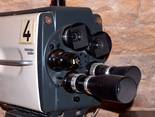Zum Auffrischen und Erinnern . . . .
. . . sind diese Seiten hier gedacht, denn viele wissen nicht mehr oder noch nicht, wie es damals angefangen hat und wie das wirklich funktioniert mit dem Fernsehen, den Kameras, den Videorecordern, den Tonband- und den Magnetband- geräten aus alter Zeit. Viele Bilder können Sie durch Anklicken vergrößern.
Es war damals - 1982 - "25 Jahre VTR" - eine Chronik
THE HISTORY OF AMPEX VIDEOTAPE RECORDING (VTR)
Worldwide recognition of Ampex´s technical achievements associated with video recording began in 1956, when the Ampex VR-1OOO was used in the coast-to-coast recording and broadcast of "Douglas Edwards and the News" for CBS on November 30. The milestone won Ampex an "Emmy" from the Academy of Television Arts and Sciences.
Many important dates have followed those pioneering days, some of them significant in the history of television recording and programming as well as to professional users.
Some of the more important dates for Ampex include:
- 1959: An Ampex color videotape recorder at a Moscow trade fair is used to record the celebrated Nixon-Khrushchev "Kitchen Debate"
- 1964: The VR-2000, a high band broadcast videotape recorder, that permits improved color and duplication characteristics, is introduced by Ampex and soon becomes the industry standard.
- 1966: Ampex, still the leading producer of professional broadcast recorders, delivers its 500th high band color videotape recorder. The company also introduces the VR-1200, a high band broadcast color and monochrome recorder for medium and small television stations.
- 1967: Ampex introduces the HS-100 "instant replay" recorder, the first high band color disc recorder for playback of short program segments in normal, slow or stop action. First used by ABC-TV in coverage of the "World Series of Skiing."
- 1967: Ampex introduces three new VTRs: VR-3000, the first battery powered broadcast recorder with high band color recording capability, and the VR-2000B and VR1200B high band color VTRs.
- 1967: Ampex receives its second "Emmy" for the development of high band recording.
- 1967: The 1,000th high band VTR manufactured by Ampex is delivered to WCIA-TV, Champaign, Illinois.
- 1968: More than $6 million worth of Ampex equipment is used to record the 1968 Winter Olympics in Grenoble and the Summer Olympics in
- Mexico City.
- 1969: Ampex introduces a "third generation" broadcast videotape recorder, the AVR-1. Today, the AVR-1 is as widely used as were its predecessors, the VR-1000 and the VR-2000 Series.
- 1970: Ampex receives a citation from the Academy of Television Arts and Sciences for development of "instant replay" color disc recorders.
- 1970: The ACR-25, an automatic video cassette recorder, is marketed by Ampex for use in programming of short segments for television stations.
- 1972: The 20th Summer Olympiad in Munich is broadcast by major TV networks throughout the world to more than one billion viewers using more than $10 million in Ampex videotape, disc and audio recorders.
- 1974: Ampex introduces the AVR-2, the first modular quadruplex recorder/reproducer for professional broadcasters. The studio console
version of the system weighs approximately 600 pounds and uses just one-third to one-half the operation space required by existing quad
recorders. It becomes the most successful quad recorder in Ampex history. - 1975: The company delivers the 200th ACR-25 automatic cassette recorder to WAVE-TV, Louisville, Kentucky, and the 500th AVR-2 to Australia TV station Ten-10.
- 1976: Ampex equipment worth more than $14 million is utilized to broadcast the Winter Olympic Games from Innsbruck, Austria, and the
Summer Games from Montreal. - 1976: Ampex starts the helical videotape recorder revolution with introduction of the VPR-1 with automatic scan tracking (AST), and a
portable model, the VPR-10. Designed for professional broadcast, C CTV, and post-production users, the VPR-1 with AST provides broadcast
quality slow motion and still-frame playback. - 1978: The VPR-2 and its portable companion, the VPR-20, are introduced in the new Type "C" format. They retain the exclusive features of the VPR-1 and the VPR-10.
- 1978: Ampex signs add-on contracts with the American Broadcasting Company for 83 VPR-2s, with an option to purchase up to 37 more units.
The contract represents the largest number of VTRs ever sold by Ampex under one agreement. - 1979: Ampex receives its third and fourth "Emmy" awards: from the Academy of Television Arts and Sciences, Hollywood, for the development
of AST technology, and from the National Academy of Television Arts and Sciences, New York, for development of the Type "C" format. - 1979: Ampex delivers the 1,000th VPR-2 to WBBM-TV, Chicago.
- 1980: Ampex introduces the VPR-2B, an enhanced version of the VPR-2 that incorporates several new features including reverse slow motion.
- 1980: Datacommunications, Paris, takes delivery of the 2,000th VPR-2. 1981: McDonnell-Douglas, St. Louis, takes delivery of the 3,000th VPR-2 - the 4,000th system from the VPR Series.

